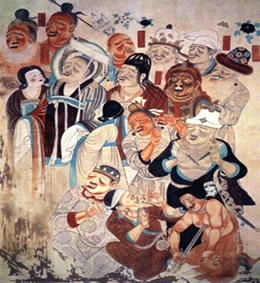


| SILK ROAD STOP: DUNHUANG |
|
| Dunhuang Slideshow |
|
|
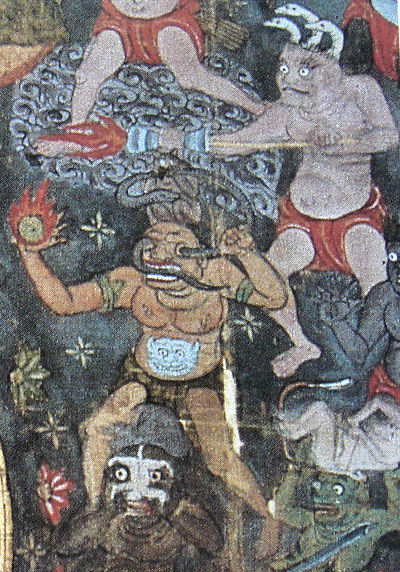
Mural of Buddha (to left, not shown) with demon using Chinese bamboo handgun

Painting of Chinese Rocket

Preparing gunpowder

Today, hunters use gunpowder within the shell to fire their weapon.
Gunpowder (Invented in China)
Invented around 850 CE by Taoist alchemist (Chinese scientist’s)"Gunpowder is composed of about 75 percent saltpeter (potassium nitrate), 15 percent powdered charcoal, and 10 percent sulphur.
The Chinese used gunpowder to make fireworks and for signal flares. Gunpowder was also thought to have uses in medicine and in alchemy (the "science" of trying to change non-precious elements into gold). Soon after its invention, the Chinese used gunpowder for weapons (which they called fire arrows). Fire rockets were made by filling capped bamboo tubes with gunpowder and iron bits (shrapnel). These lethal weapons were attached to an arrow, lit, and shot from a bow. These were the first solid-fuel rockets. The Chinese used them to fight the invading Mongols." (Enchanted Learning)
The first use was on an incendiary projectile called flying fire in 904 against the Mongols. Flying fire was a tube of gunpowder attached to an arrow that when ignited would propel itself as a rocket and be fired at the enemy. Soon, it appeared in mortar tubes that that were first made of bamboo chutes, but later were created of metal or bronze and was shot from these tubes as an explosive at the enemy. It is believed that the idea of gunpowder was spread to other civilizations via the route of the Silk Road. The invention of gunpowder was obviously important to the Chinese because of its use in warfare. Because it was mainly used to make projectiles and rockets, it revolutionized warfare and gave the Chinese an advantage in battle because of its more devastating effect than regular bows and arrows. It was also psychologically devastating to the enemy who had never seen this before and felt overwhelmed by the advantage that the Chinese had. This allowed them to take over and over-throw civilizations and dynasties easier and protect them themselves more confidently from enemy attacks.
Video: The Invention of Gunpowder

Beijing Olympic Fireworks Show
Gunpowder's Impact Today:

Military police officer with gun in Shanghai, China
Gunpowder is used for firework displays you might see on the 4th of July in the USA or the Beijing Olympics. It is also used for blasting rock to make way for roads and in mining minerals. Surprisingly, you will find it in some denture creams and artificial cheese! Of course, gunpowder is still used to propel bullets out of guns and in artillery shells in the military.

Picture of earliest known European cannon.

Muslim armies prepared and used fire arrows made with gunpowder.

Cannon on British ship used in the Opium Wars against China
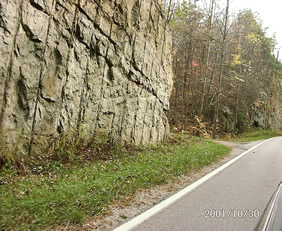
Road created by dynamiting rock to make path
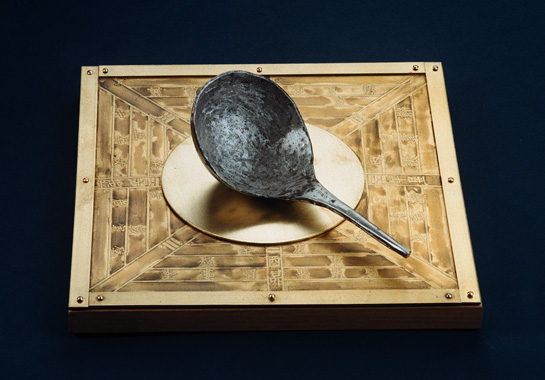
Chinese ladle compass (Smith College)
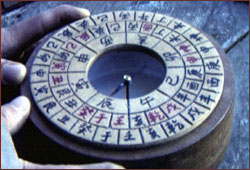
Chinese

Magnetic Compass
The magnetic compass followed the discovery of lodestone (magnetic iron ore) in China around 100 B.C.E. Crafts workers carved lodestone into the shape of a ladle and set it on a smooth surface. The heavier, spoon shaped part swiveled north; the long, thin handle pointed south. The Chinese then discovered that iron rubbed against lodestone also becomes magnetic. Around C.E. 1000 the Chinese began making steel from iron, and from this steel they made fine compass needles. A true compass, with a magnetiezed steel needle pivoting on a bamboo pin, was invented by the Chinese in the 11th century.
The Compass Spreads
The full story of how the compass reached Europe is not known. Most likely Arab sailors brought the compass to Arab ports, and from there to European ports. By the end of the 12th century, Europeans had learned to make and use the compass.
The Compass Today:
The compass is used today for orienteering, hiking, navigation in cars (without GPS), and more. Global positioning systems using satellite technology is taking the place of the compass in many cases, but the compass is still cheap and essential to many people who don't want to get lost in the woods.
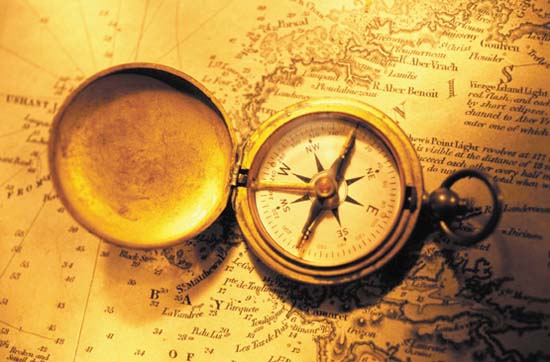
Magnetic compass used by European sailors
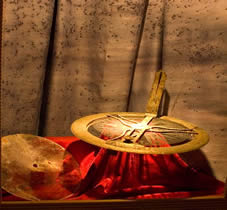
Bearing Compass for Surveying (Sweden)

Rearview mirror with embedded compass

